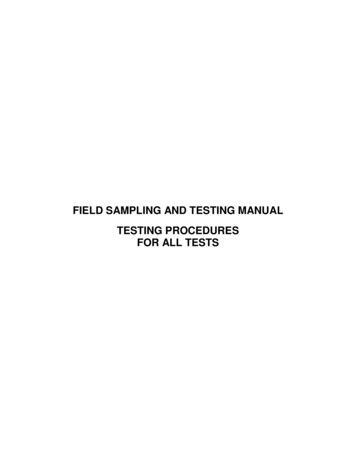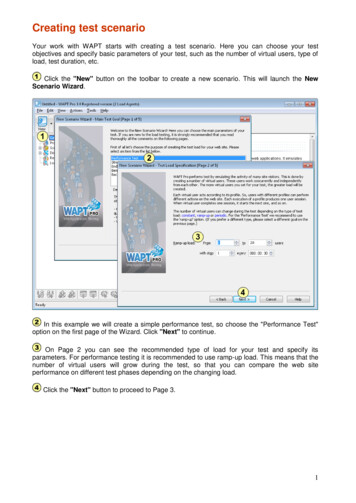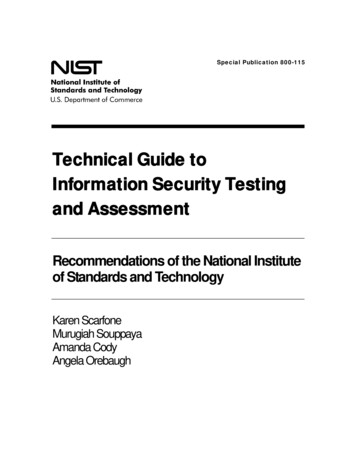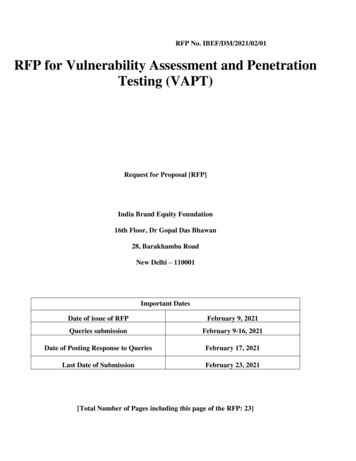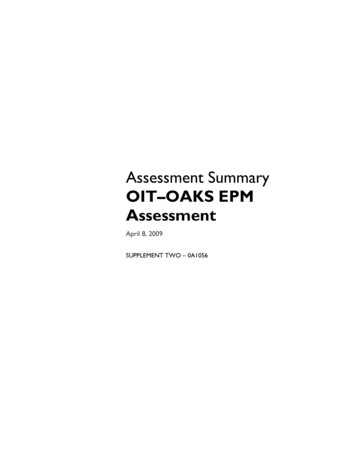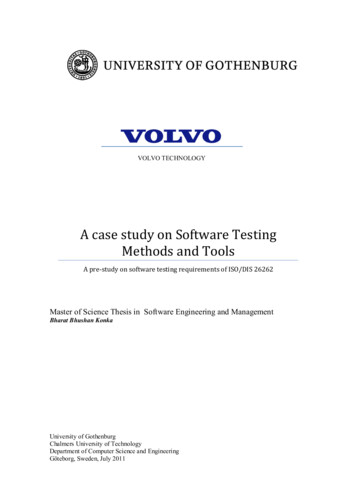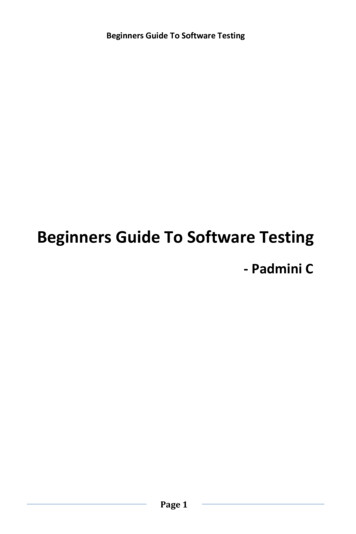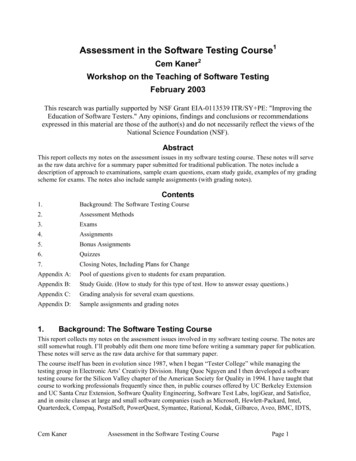
Transcription
Assessment in the Software Testing Course1Cem Kaner2Workshop on the Teaching of Software TestingFebruary 2003This research was partially supported by NSF Grant EIA-0113539 ITR/SY PE: "Improving theEducation of Software Testers." Any opinions, findings and conclusions or recommendationsexpressed in this material are those of the author(s) and do not necessarily reflect the views of theNational Science Foundation (NSF).AbstractThis report collects my notes on the assessment issues in my software testing course. These notes will serveas the raw data archive for a summary paper submitted for traditional publication. The notes include adescription of approach to examinations, sample exam questions, exam study guide, examples of my gradingscheme for exams. The notes also include sample assignments (with grading notes).Contents1.Background: The Software Testing Course2.Assessment Methods3.Exams4.Assignments5.Bonus Assignments6.Quizzes7.Closing Notes, Including Plans for ChangeAppendix A:Pool of questions given to students for exam preparation.Appendix B:Study Guide. (How to study for this type of test. How to answer essay questions.)Appendix C:Grading analysis for several exam questions.Appendix D:Sample assignments and grading notes1.Background: The Software Testing CourseThis report collects my notes on the assessment issues involved in my software testing course. The notes arestill somewhat rough. I’ll probably edit them one more time before writing a summary paper for publication.These notes will serve as the raw data archive for that summary paper.The course itself has been in evolution since 1987, when I began “Tester College” while managing thetesting group in Electronic Arts’ Creativity Division. Hung Quoc Nguyen and I then developed a softwaretesting course for the Silicon Valley chapter of the American Society for Quality in 1994. I have taught thatcourse to working professionals frequently since then, in public courses offered by UC Berkeley Extensionand UC Santa Cruz Extension, Software Quality Engineering, Software Test Labs, logiGear, and Satisfice,and in onsite classes at large and small software companies (such as Microsoft, Hewlett-Packard, Intel,Quarterdeck, Compaq, PostalSoft, PowerQuest, Symantec, Rational, Kodak, Gilbarco, Aveo, BMC, IDTS,Cem KanerAssessment in the Software Testing CoursePage 1
Tideworks, Wind River, Cigital, and many others.) A recent version of my commercial course notes isavailable at http://www.testingeducation.org/coursenotes/kaner cem/cm 200204 blackboxtesting.I modified the course for academic use in 2000 and have taught the academic course at Florida Tech fivetimes, modifying it (especially in the assessment) each time. A version of my academic course notes isavailable at http://www.testingeducation.org/coursenotes/kaner cem/ac 200108 blackboxtesting.The academic course focuses on black box software testing. I teach a second course in glass box testing thattakes the black box course as a prerequisite.The black box course has five core topic areas, which I prioritize as follows: Paradigms of software testing: a look at 9 dominant styles of black box testing. Students applyseveral of these to a sample application, such as StarOffice. Bug advocacy: effective replication, analysis, and reporting of bugs. Test documentation: examples of test documentation components and an overview of requirementsanalysis to determine what is needed in what context. Additional test design issues: The primary examples are an overview of GUI-level regression testingand design of these tests for maintainability, and all pairs combination testing. Process and organizational issues: We look primarily at the structure and missions of typicalsoftware testing groups and the implications for testing of different software lifecycle models. Thismaterial is presented primarily to provide context for those students who have no industrialexperience, and to provide exposure to alternative contexts for students who have worked only inone or two companies.Several other topics come and go in the class, depending on student interest, applicability to the sampleapplication that we are testing, and various other factors. These have included state-model-based testing,software test metrics, high volume test automation, status reporting, project planning, quality/cost analysis,failure modes and effects analysis, and finding a job in software testing.This report focuses on assessment issues, and so I will not further discuss the choice of topics here.Throughout the course, we apply what we learn to a sample application. So far, we’ve used the TI InteractiveCalculator and the word processing and the presentation modules of OpenOffice. Another senior member ofour faculty (James Whittaker) also uses sample applications in his testing courses, primarily Microsoftproducts under development.I recommend working with the open source products for several reasons: The students bug reports are publicly available. This can help them at job interview time (they canpoint to records of their actual work product). It also encourages them to take the reporting taskseriously. Students can see the progress of their bugs through the bug reporting system, watching commentsdevelop on their bug reports, reporting fixes, complaining of non-reproducibility, asking for moreinformation, and so on. They get to participate in a series of real-project bug discussions, gaininginsight and experience that will be directly applicable on the job. The students’ work is valued and they get personal feedback. This is not true of all open sourceprojects, but an instructor can get a sense of the feedback style on the project by examining thereports already in the bug tracking database before selecting an application.2.Assessment MethodsAssessment is the course’s primary educational tool.I give lectures and students (academic and commercial) generally like them, but lectures can only transmit somuch information, and students forget them anyway.Cem KanerAssessment in the Software Testing CoursePage 2
I use the lectures to provide a structure for the material and to provide real-life examples, compelling orentertaining stories that will help students understand how or why a technique was used in practice, what theeffects of different life cycle models can be, and so on. The lectures create contexts for the material.During the lectures, I also run several discussions focused on hypotheticals or thought experiments. Theseare effective learning tools for some students.My expectation is that most students will do most of their learning while doing homework, assignments, andstudying for, writing, and reviewing the results of tests and exams.I encourage students to work together when they do assignments. In general, encouraging collaboration(students co-sign artifacts that they work on together, with the explicit expectation that more co-authors mustproduce more work), seems to have been effective in eliminating plagiarism. The collaboration is doneopenly instead of secretly.However, because 35% of the final grade comes from the assignments, there is an incentive for a weakstudent to pair with a stronger student in order to cash in on the high marks the stronger student will earn.The first few times that I taught the course, this was a serious problem and at least two students passed thecourse who probably should not have. I addressed this problem with the following policy, printed in thesyllabus (and reviewed with students in the first class):To pass the course, you must have a passing average on the mid-term test and the final exam. Undergraduates (CSE 4431): If the average of your mid-term test and your final exam is below 60%,you will fail the course no matter how well you do on the assignments and no matter how many bonuspoints you have. Graduates (SWE 5410): If the average of your mid-term test and your final exam is below 68%, youwill fail the course no matter how well you do on the assignments and no matter how many bonuspoints you have.You can earn grades as follows In-class quizzesAssignmentsMid-term testFinal examBonus Assignments (including bug reports)o Bug reportsTotal points availableup to 5% (1% per quiz, pass/fail grading)30-35% (depends on the number of quizzes)25%40%up to 10%up to 5%110%I don't grade on a curve. If everyone gets 90% or more, everyone gets an A. (B is 80-89; C is 70-79; D is 60-69;F is 0-59).Since adopting the threshold policy, I haven’t seen as much obvious imbalance in effort on the assignments.The student who can’t pass the exams can’t pass the course.3.ExamsTo maximize the educational benefits from the mid-term and final exams, I hand out a pool of questions afew weeks before the exam. The exam questions are selected from the pool. The exam is closed book.3.1BenefitsThe most important benefit of this approach is that it allows the students to think through their answersand prepare them carefully. The exam is merely a production exercise--the student isn’t spending precioustime trying to understand each question and think through a strategy for answering it. Because I can assumethat the students have thoughtfully developed their answers, I can apply a higher standard when I grade theanswers.Cem KanerAssessment in the Software Testing CoursePage 3
Another important benefit is that it gives the students structure for studying together. I encourage studentsto review and discuss each others’ answers.3 The questions focus their work, give them something explicit towork on.A third benefit is that this approach allows me to ask complex questions without unfairly disadvantagingstudents whose native language is not English. People read at different speeds. Students whose Englishlanguage skills are still under development need extra time to read and comprehend essay questions and tostructure their answers. Because they have that extra preparation time, I don’t have make allowances forthem when I grade.3.2Source materialAppendix A lists questions that I’ve used in the course.Appendix B is an instruction / suggestion sheet that I give students with the questions. The sheet includestwo types of guidance: How to study for this type of test How to answer questions on this type of test.Appendix C provides analyses and answers for several of the exam questions.3.3Risks and ProblemsThe primary problem with this course’s approach is that many students aren’t used to answering essayquestions and so they deal with them ineffectively. This problem is not unique to computer science students.For example, teaching first year law students how to answer essay questions is a critical task, repeated incourse after course.4 Many universities publish guidelines for undergraduates on how to study for, andorganize, essay questions.5The problems that I note here apply broadly to essay-format exams among graduate students in computerscience. For example, at Florida Tech in Fall, 2002, a substantial minority of the population of studentswriting the Software Engineering Comprehensive Exam failed or nearly failed the exam because ofineffective essay-answering strategies that yielded weakly structured answers that missed important points or shotgun answers (unfocused, not directly responsive to the question).3.3.1 Weak StructureConsider the following question as an example:Define a scenario test and describe the characteristics of a good scenario test. Imagine developing a setof scenario tests for the Outlining feature of the word processing module of OpenOffice. What researchwould you do in order to develop a series of scenario tests for Outlining? Describe two scenario teststhat you would use and explain why each is a good test. Explain how these tests would relate to yourresearch.This has several components: Define a scenario test Describe the characteristics of a good scenario test What research would you do in order to develop a series of scenario tests for Outlining? Describe two scenario tests you would use. Explain why each of the two scenario tests is a good test Explain how these two scenario tests would relate to your researchCem KanerAssessment in the Software Testing CoursePage 4
A well organized answer will have at least six sections, one for each of the bulleted components. You mighthave two additional sections, by splitting Describe two scenario tests you would use and Explain why each ofthe two scenario tests is a good test into two sections, one for each test.Without structure, it is easy to miss a section and thereby to lose points.Students must learn to focus their answer to match the “call of the question” (the specific issues raised in thequestion).It is a safe bet that a substantial portion of the undergraduate or graduate CS students who attend the softwaretesting class will not yet have sufficiently developed their skills in identifying and responding to the call ofthe question.3.3.2 Shotgun AnswersA student using a shotgun strategy responds with a core dump of everything that seems to be relevant to thegeneral topic. Much of this information might be correct, but if it is non-responsive to the call of thequestion, it is irrelevant and I will ignore it. However, to the extent that irrelevant information is incorrect, ifI notice an error, I will deduct points for it.Here’s an example of a question that yielded a lot of shotgunning and not enough points:Imagine that you are an external test lab, and Sun comes to you with OpenOffice. They want you to testthe product. When you ask them what test documentation they want, they say that they want somethingappropriate but they are relying on your expertise. To decide what test documentation to give them,what questions would you ask (up to 7 questions) and for each answer, how would the answer to thatquestion guide you?In the course, we looked over a long list of requirements-eliciting questions.6 Students were free to use theones we discussed or to supply their own.The question
software testing groups and the implications for testing of different software lifecycle models. This material is presented primarily to provide context for those students who have no industrial experience, and to provide exposure to alternative contexts for students who have worked only in one or two companies. Several other topics come and go in the class, depending on student interest .



